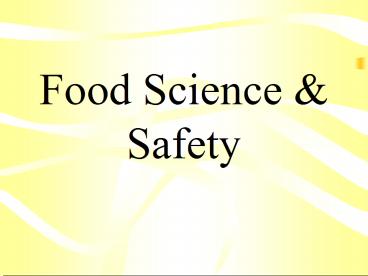Food Science - PowerPoint PPT Presentation
1 / 11
Title:
Food Science
Description:
Food Safety - How to fight BACTERIA. Four steps to ... Cook roasts and steaks to at least ... Cook ground meat, where bacteria can spread during grinding, to ... – PowerPoint PPT presentation
Number of Views:111
Avg rating:3.0/5.0
Title: Food Science
1
Food Science Safety
2
Objectives
- Describe food safety practices
- Describe the four steps to insure safe food.
- Recall myths and truths about refrigerating and
defrosting food.
3
Food Safety - How to fight BACTERIA
4
Four steps to keeping food safe
- Clean - Wash hands and surfaces often
- Separate - Dont cross-contaminate
- Cook - Cook to proper temperatures
- Chill - Refrigerate promptly
5
CLEAN
- Wash hands in hot soapy water . Wash for at
least 20 seconds. - Wash cutting boards, knives, utensils and counter
tops in hot soapy water after preparing each food
item and/or before beginning the next one. - Use plastic or other non-porous cutting boards.
Cutting boards need to be washed after each use. - Consider using paper towels to clean up kitchen
surfaces.
6
Separate
- Separate raw meat, poultry and seafood from other
foods in the grocery shopping cart. - Store raw meat, poultry and seafood on the bottom
shelf of the refrigerator so juices wont drip on
the other foods. - Use one cutting board for raw meat and one for
everything else like salads if that is possible. - Always wash cutting boards, knives and other
utensils with hot soapy water after they come in
contact with raw meat. - Never place cooked food on a plate which
previously held raw meat.
7
Cook
- Use a meat thermometer (measures the internal
temperature of the meat) to make sure that it is
cooked all the way. - Cook roasts and steaks to at least 145
Fahrenheit. Whole poultry should be cooked to at
least 180 Fahrenheit to be completely done. - Cook ground meat, where bacteria can spread
during grinding, to at least 160 F. - Cook eggs until the yolk and white are firm, not
runny. Dont use recipes in which eggs remain
raw or only partially cooked.
8
Cook
- Cook fish until it is opaque and flakes easily
with a fork. - Make sure there are no cold spots in food (where
bacteria can survive) when cooking in a
microwave. - Bring sauces, soups and gravy to a boil when
re-heating. Heat leftovers thoroughly to 165
F.
9
Chill
- Refrigerate or freeze perishables, prepared food
and leftovers within two hours. - Never defrost (or marinate) food on the kitchen
counter. Use the refrigerator, cold running
water, or the microwave. - Divide large amounts of leftovers into small,
shallow containers for quick cooling in the
refrigerator. - With poultry and other stuffed meats, remove the
stuffing and refrigerate it in a separate
container. - Dont pack the refrigerator. Cool air must
circulate to keep food safe.
10
Myths and Facts about Food Safety
- Myth It will harm my refrigerator or ruin other
foods if I put hot food inside, so I should let
food cool first. - Fact Hot food will not harm your refrigerator
or ruin other foods. Actually, the sooner you
refrigerate foods the safer you and your food
will be.
11
Myths and Facts about Food Safety
- Myth I can safely thaw food on my kitchen
counter at room temperature. - Fact Remember, bacteria grow rapidly at room
temperature and you should avoid keeping foods in
the Danger Zone any temperature between 40 F
and 140 F.































